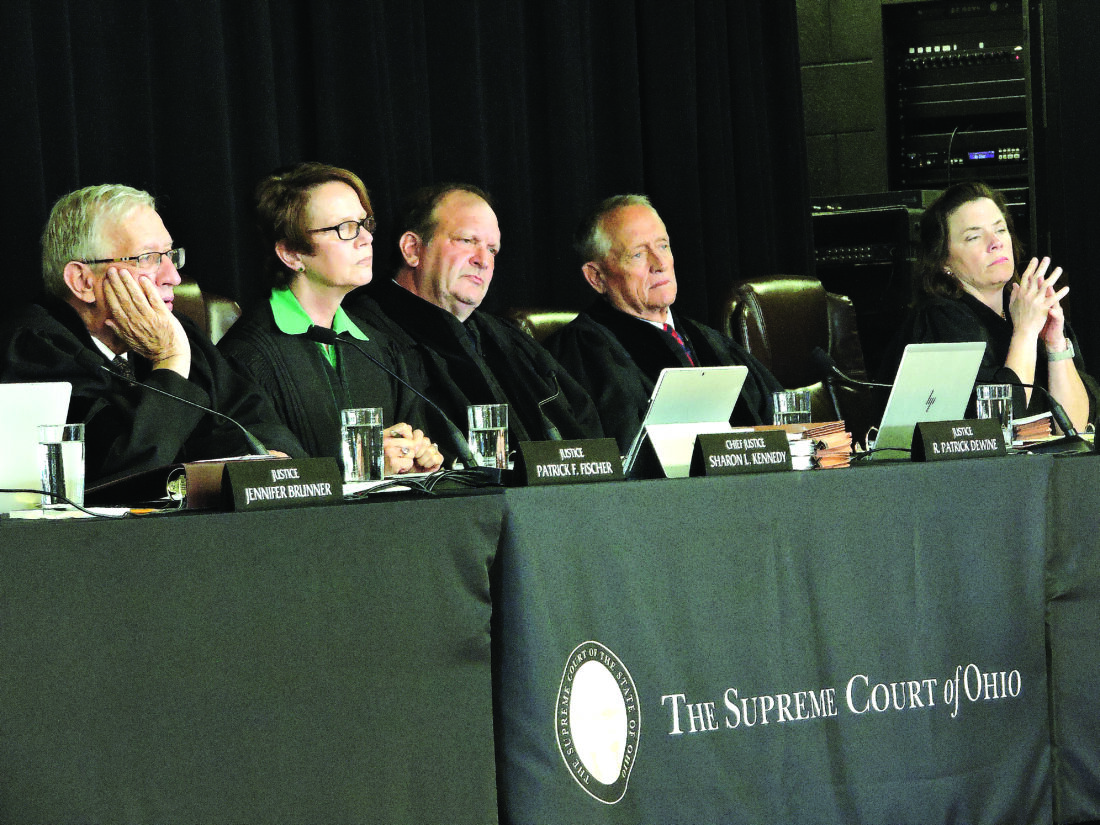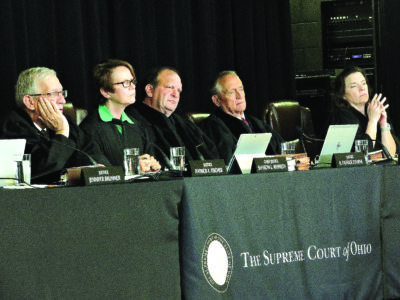Monroe Central hosts the Ohio Supreme Court

Photo by Emma Delk Supreme Court of Ohio Justices Patrick F. Fischer, Chief Sharon L. Kennedy, R. Patrick DeWine, Joseph T. Deters and Megan Shanahan hear oral arguments for the State of Ohio vs. Dorian Crawl during the Off-Site Court Program at Monroe Central High School on Wednesday.
WOODSFIELD — Monroe County high school students had front-row seats to witness how the highest court in the state operates during the Supreme Court of Ohio’s Off-Site Court Program held at Monroe Central High School on Wednesday.
More than 400 students from Monroe Central High School, Beallsville High School, River High School and Swiss Hills Career Center heard oral arguments for three cases brought to the court during the program.
The high school cafeteria was transformed into a courtroom for students and members of the public to watch the session. The justices sat on a stage in front of the audience while the attorneys affiliated with each case side made their 15-minute oral arguments. The court will decide on the merits of the three cases heard on Wednesday several months after hearing the oral arguments.
Before the court was called into session, Chief Justice Sharon L. Kennedy welcomed the students and informed them that Wednesday marked the 84th session of the Off-Site Court Program. She noted that students would have the “unique opportunity” to observe oral arguments and interact with justices, attorneys and court staff throughout the day.
“Our purpose in being here today is not just to conduct the court’s business, but to ignite a lifelong curiosity of the law,” Kennedy said. “The legal system is not something abstract or distant. It is an integral part of everyone’s life, providing order and structure as we work together to create a fair and just society. By observing today’s proceedings and participating in this year’s program, you are actively engaging with the principles that underpin our great state and nation.”
The first case the students heard was the State of Ohio v. Dorian Crawl. The case sought to review the Second District Court of Appeals decision affirming Crawl’s conviction for violating Ohio’s anti-stalking statute based on “benign comments” Crawl made on a social media post. Crawl moved for the case to be dismissed due to the state’s failure to submit “sufficient evidence of the elements of knowledge and pattern of activity” to support a stalking conviction.
The second case was the State of Ohio v. Edward Balmert. After sideswiping an Ohio State Highway Patrol trooper with his vehicle, Balmert argued that his aggravated vehicular assault conviction was supported by insufficient evidence of proximate cause. This was based on the marijuana metabolite levels taken from his urine sample taken after the crash.
The arguments heard for the second case centered around whether an Operating a Vehicle while Intoxicated violation is sufficient to satisfy the proximate cause requirement, meaning that a direct sequence produces the event complained of, for aggravated vehicular assault or homicide.
The final case was the State of Ohio v. Mamadou Diaw. Diaw allegedly robbed a person he encountered during the sale of a laptop arranged through LetGo, a social media platform similar to Craigslist. The oral arguments centered around whether detectives’ use of a single GPS data point from Diaw’s phone to identify him as a suspect in a robbery violated his Fourth Amendment protections. Diaw’s representation argued that individuals maintain a privacy interest and attendant Fourth Amendment protections “in the whole of their movements, including their physical location.”
The four participating schools cycled through the courtroom in three separate groups, each hearing the case assigned to them. A lawyer involved with the case that was assigned to a school visited students in the lead-up to the court session to teach them about the case’s background.
After their assigned case was heard, each group of students participated in a debriefing session in the auxiliary gym. During these sessions, students asked lawyers involved in the case questions about what they had just witnessed.
The last station of the event was a meet-and-greet with State Sen. Brian Chavez. Students also watched an introductory video that informed them about the various careers available to them in the legal field, which focused on the Monroe County court system.
Administrative Director of the Supreme Court of Ohio Bob Horner stressed the importance of the students’ preparatory work and debriefing sessions paired with hearing the oral arguments. He noted that the cases heard on Wednesday covered “interesting subject matters” that were more relatable to the students, with the Balmert and Diaw cases involving social media use.
“If someone walks into the oral argument session without any context, they get a little bit of flavor of the case and see more of the mechanics of the court,” Horner said. “I think the actual content of the case is a big part of the educational process, in addition to students witnessing how the court members and the counsel interact and what their dialogue is like. In terms of understanding the cases, the preparatory work is very important.”
Monroe Central High School student Grace Swisher, a student ambassador for the Off-Site Court Program, said she was surprised by the content of the Crawl case her group heard on Wednesday. She was unaware that the court could take cases on topics that were “not as serious,” such as social media.
“I was kind of surprised by the case, but I could see how there were different sides to it that were arguable,” Swisher said. “I’ve really only seen how the court operates through various things like TV shows and stuff, so I didn’t really have a grasp on how intricate everything was. It was really cool to learn about.”
Monroe Central High School student Davon Bourne decided to become a student ambassador for the Off-Site Court Program because of his own legal aspirations. Bourne, who wants to become an international lawyer, said it was “very cool” to see the Supreme Court of Ohio in session.
“I thought it was cool to see how the justices made a few jokes with each other and made us laugh,” Bourne said. “I thought it would be a more serious situation, but it was cool to see that they are human too, not just judges or lawyers.”
Monroe Central Principal Casey Tolzda was excited that all students, not just those interested in a legal career, were able to participate in the program. He noted that the school has a segment of students interested in politics or a legal career who can participate in the school’s mock trial program. For students not interested in the law, Tolzda said the Off-Site Court Program still taught them how the judicial branch operates.
“Even students who are not interested in a legal career path get to see the process of the courts and how all the branches of government work together,” Tolzda said. “We can all be guilty of not being educated enough regarding our government, so I am glad these students got this educational experience. The entire process has been interesting and eye-opening, not only for the students, but I think for all of us involved.”





